Crime in California 2024
by Steve Smith | July 15, 2025
On July 1, as it has for over 50 years, the California Department of Justice released three statistical reports covering crime in general, homicides, and juvenile crime. On the positive side, there are some reductions particularly in violent crime and auto thefts. Yet sexual assaults are up, statistical flaws remain, and clearance rates were very low. Unreported crimes and low clearance rates expose the operational and policy shortcomings of California’s criminal justice system.
At first glance, the official statistics indicate an overall 6 percent decline in violent crimes in the following categories: 10.4 percent for homicides; 6.5 percent for aggravated assaults; 6.3 percent for robberies; and 19.6 percent for assaults with a firearm. Only rape showed an increase of 4.8 percent.
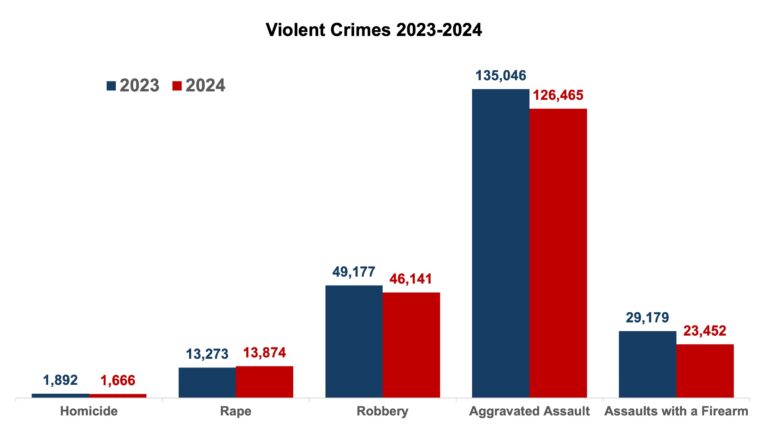
Upon further analysis, when 2024 statistics are compared to the 2023 statistics, this is where the problems begin. According to Crime in California 2023, 28 law enforcement agencies failed to contribute crime statistics to the DOJ, resulting in a crime undercount. Those 28 agencies included the San Jose PD and San Bernardino Sheriff’s Office. In 2022, San Bernardino reported 77 homicides and San Jose an additional 35. If 2022 homicides are an indicator of 2023 homicides, over 100 homicides are possibly missing from the official stats. Most of the remaining 26 agencies do not maintain publicly accessible crime statistics.
Conversely, Oakland PD overreported crime to the California Department of Justice in 2023. According to those statistics, there were 6,395 violent crimes in 2022 and 15,372 in 2023 – an increase of a barely credible 140 percent. Further investigation showed those statistics were the result of human error. When corrected, the percentage was revised downward to a 21 percent increase.
The California DOJ does not correct crime statistics once they are published, however, they do issue cautions that there may be errors in their reporting.
Consequently, that error remains in the 2023 Crime in California report and according to an investigation by the San Francisco Chronicle, were it to be corrected, the state’s reduction in violent crime would be just 2 percent.
The Chronicle report doesn’t address the 28 agency underreport.
Nevertheless, in his office’s press release regarding the 2024 statistics, Gov. Newsom was quick to point out that California had lower homicide rates than several other states and the lowest homicide rate in California since 1966, when the rate was 4.7/100,000.
If 1966 is the benchmark by which Newsom measures success, the homicide rate for the Newsom administration has exceeded that rate 4 out of his 6 years in office. Or, had homicides in California remained at just their 2018 level (the year before he assumed office), an additional 1,632 Californians would be alive today.
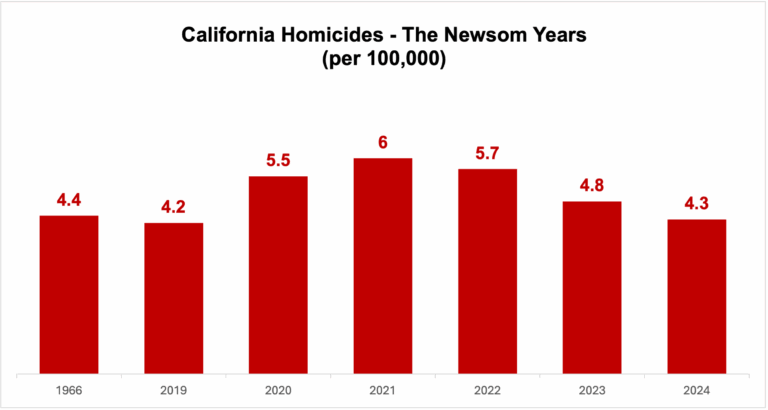
Rates are an important way of comparing states of varying sizes. Unfortunately, rates hide the sheer numbers of crime victims. Since homicides are an exceptionally reliable statistic, it bears saying that in the last seven years, 13,745 Californians have been murdered.
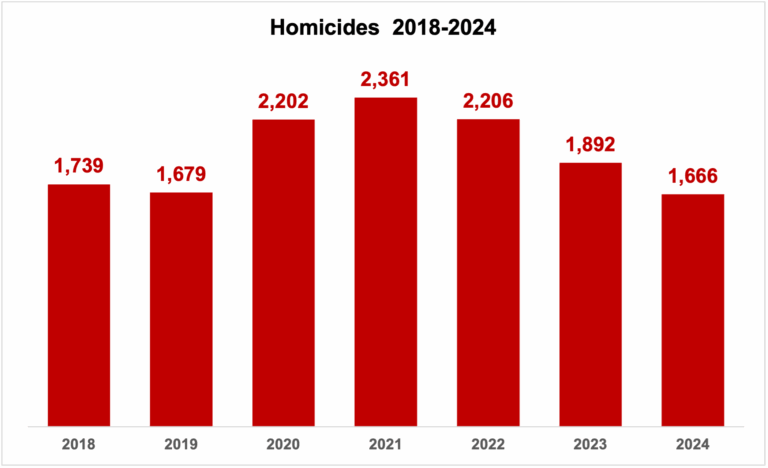
Clearances
Clearances are the measure by which crimes have been solved by arrest and, like crime statistics are a measure of public policy effectiveness, clearances indicate police investigatory effectiveness.
For example, in 2024 there were 1,666 homicides and 1,305 homicide arrests. According to crime statistician Jeff Asher, who compiled national homicide clearance rates for a recent NY Times report, nationwide only 58 percent of homicides are solved. By that measure California is doing far better than the national average in terms of solving murders.
The 2024 overall arrest rate is up 2.4 percent, although general felony arrests declined by .7 percent, violent felony arrests are up 2.9 percent and the total property crime arrest rate declined 5.1 percent.
This indicates that law enforcement agencies are having more success solving violent crimes, with the exception of rape, than property crimes.
Rape
The one category of violent crime that did not decline were rapes. The number of rapes has remained at a rate between 36.8 and 33.8 for the last 6 years.
This may be facilitated by the state legislature’s decision to classify the possession of the drug Rohypnol (known as “ruffies”) as a misdemeanor.
Rohypnol can affect a rape victim’s memory such that recollection of key information is often impossible. This makes Rohypnol a would-be rapist’s drug of choice and its use is so prevalent that bars and nightclubs are required by state law to post warnings, offer testing of drinks for adulterants, and most recently offer drink lids for patrons who request them. As these lids are not sealed, it seems a possible consequence that an untended covered drink may be better suited to identify would-be victims rather than prevent the adulteration of their drinks.
Possession of Rohypnol with intent to commit sexual assault is a felony. However, absent an independent witness, these cases are almost never prosecuted and, based on the National Crime Victimization Survey (NCVS), most rapes are not reported.
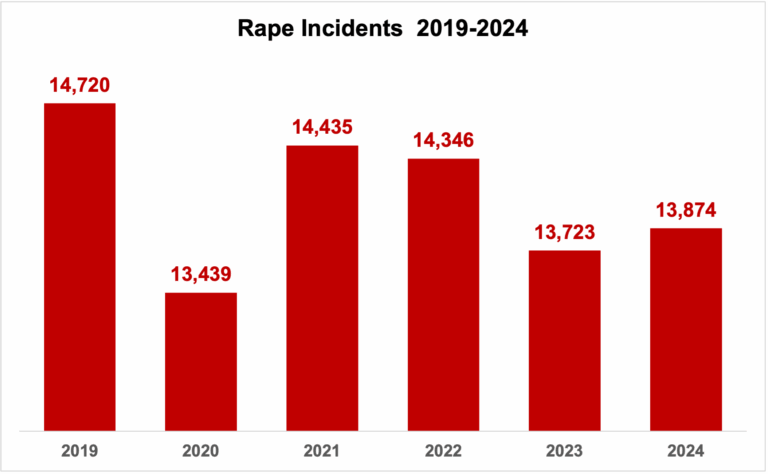
The NCVS doesn’t track victimization by state, however, based on population percentages by state, it is possible to conclude that the NVCS statistics for 2023 (the last year of the report) show that 48,000 rapes may have occurred in California, while only 13,874 were reported, and a scant 3,787 were cleared by arrest. This means the chances of a rapist being arrested are less than 1 in 10.
With no effective deterrence through arrest and incarceration, California’s tens of thousands of rape victims will likely be joined by many more in the coming years.
Prison Population and Violent Crime
It is worthy of consideration that as incarceration declines, violent crime increases. In 2019, the California Department of Corrections and Rehabilitation (CDCR) housed 124,027 inmates and in the same year 173,205 violent crimes were reported – a six year low. Yet, by 2023 the prison population had declined to 94,188 (-24 percent) while at the same time violent crime incidents increased to 199,838 (+15 percent) for a six year high.
In 2024 that ratio narrowed as the prison population and the number of violent crimes both declined, with the inmate population declining 2.8 percent and the number of violent crimes declining 6 percent. An answer to that phenomena may be in both who the CDCR is releasing and when.
A recent report by CDCR found that of 14,800 allegedly non-violent inmates who, due to the COVID-19 pandemic were released early by Gov. Newsom between April 2020 and December 2021, nearly 4,800 had been returned to prison by January 2025.
This represents a return to prison percentage of 32 percent, including 30 individuals who had committed 1stand 2nd degree murder, over 2,000 returned for firearms violations, 1,480 for assaults, 1,332 for burglary, and approximately 700 each for robbery, vehicle theft, and domestic violence, for a total of 3,430 violent or weapons offenses.
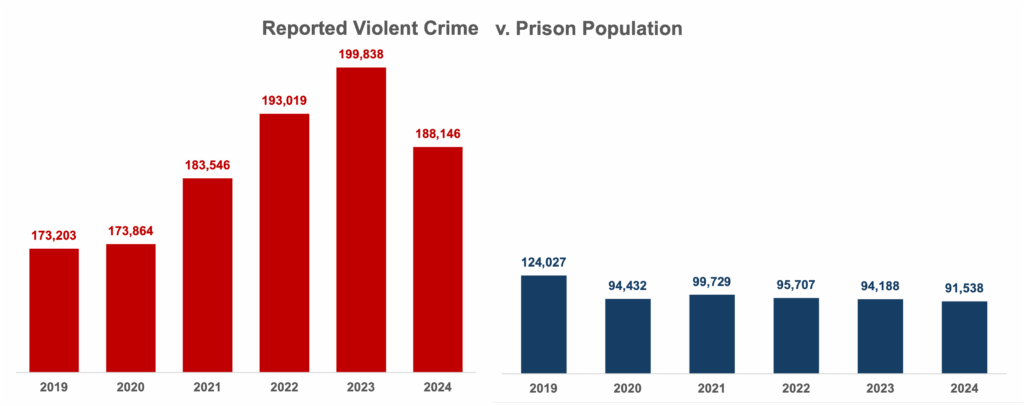
Property Crime
Despite a drop in thefts, the value of goods stolen is increasing. In 2019 the average theft amount was $3,071.00 and in 2024, despite a drop in the number of reported thefts of approximately 100,000 incidents, the average theft amount increased to $5,521.00
in 2024, the total arrest rate for property crime declined by 5.1 percent. Felony arrests for property crimes in 2019 stood at 63,357, and in 2024 they had declined to 59,116. However, petty theft arrests, mostly due to shoplifting, climbed 92 percent from 2021 to 2024, after declining 53 percent from 2019 to 2021. This is perhaps an indicator that retailers are more actively arresting shoplifters, the police are responding to those arrests, and shoplifters are getting the message.
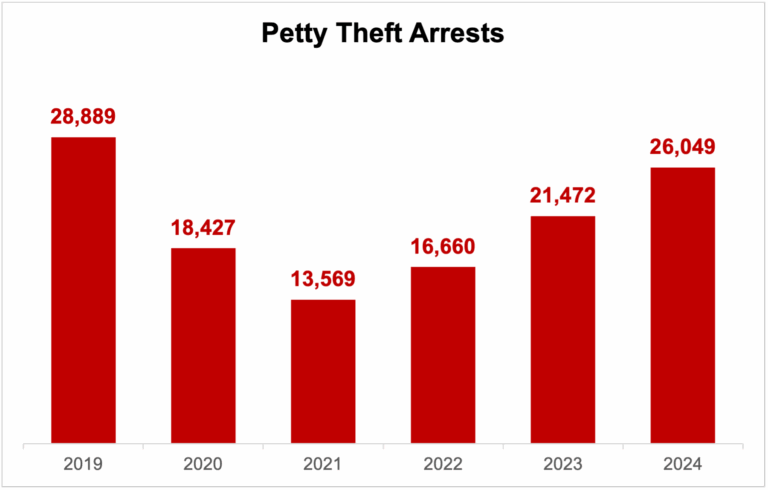
Despite the improvement in misdemeanor theft arrests, the chances that a thief will be caught and arrested still remain incredibly low. Of the 815,854 reported thefts in 2024, a total of 85,165 arrests were made, meaning there is an extremely high likelihood that thieves will get away with it.
Juvenile Crime
Juvenile arrests have largely mirrored adult arrests – higher clearance rates/arrests for violent crime and lower arrest numbers for property crime. This is indicative of a consistent pattern of policing that prioritizes crimes against persons over property crimes. Despite small declines in 2024 over 2023, juvenile arrests remain significantly above their historic lows in 2021. Most concerning are homicides where there has been a steady increase since 2019.
As shown, in 2019 there were 1,679 reported homicides, 68 of which were found to have been committed by juveniles. Yet in 2024 there were 1,666 homicides and 124 were committed by juveniles. This is a near doubling of juvenile involvement in homicide.

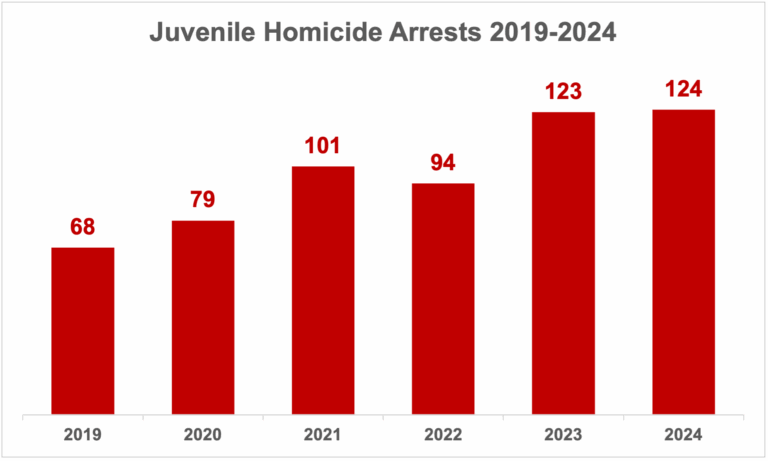
There is a correlation between juvenile arrests and incarceration statistics, particularly for violent crime. While homicide arrests have nearly doubled the number of juveniles being remanded to adult court for trial has dropped from 64 in 2019 to just 5 in 2024. In 2023 the State of California closed the Department of Juvenile Justice, formerly known as the California Youth Authority (CYA). This has left the rehabilitation of juveniles to the 58 counties who bring to the problem varying abilities and resources.
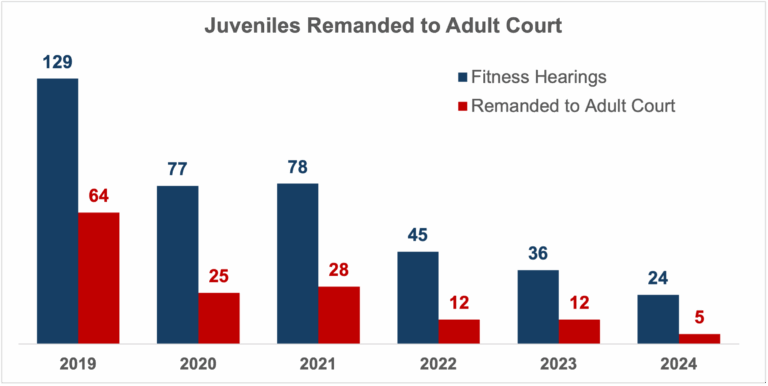
California’s criminal justice policy is one of seemingly well-meaning but perhaps ill-conceived policy decisions juxtaposed against their negative consequences.
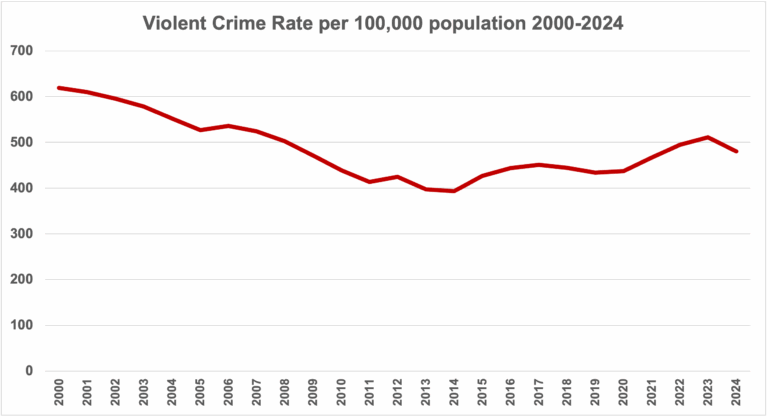
Today, violent crime rate stands at 480.3/100,000 (62 percent higher than it was in 1966). However, violent crime actually peaked in 1991 at 1,079.8/100,000, which in turn helped bring about the passage of Three Strikes in 1994. Crime then declined to its lowest point since 1966 when in 2014 it stood at 393.3/100,000.
In 2014, AB 109 was enacted and California began the transfer of over 70,000 prison inmates either out of custody or to county jails. AB 109 was followed by Props 47 and 57 that reduced criminal consequences as well as increasing the opportunities for early releases from prison. Elderly inmates are now 50 and youthful offenders are 25. This narrows the most severe criminal consequences for 26 – 49 years olds. Since then, the rate has never dropped below 4.33.
Have we reached a politically acceptable level of death and victimization. The question for policymakers today is 1966 good enough?
